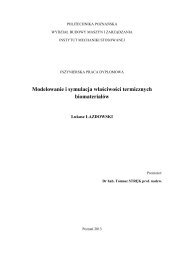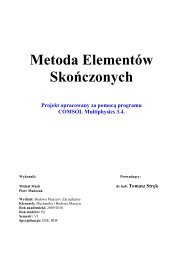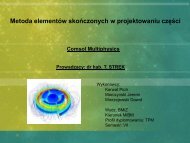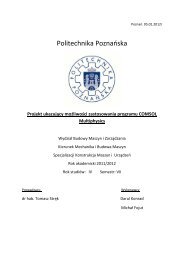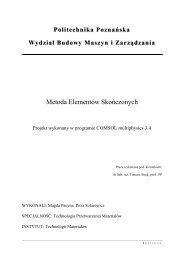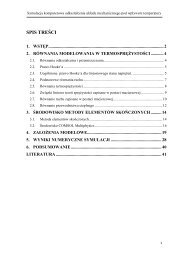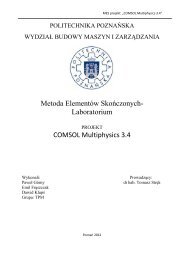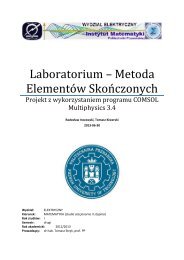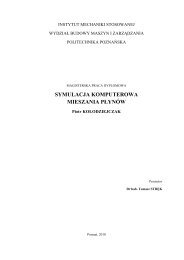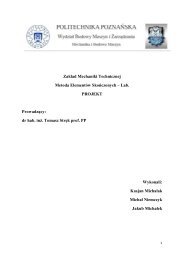Lithium-Ion Battery Simulation for Greener Ford Vehicles
Lithium-Ion Battery Simulation for Greener Ford Vehicles
Lithium-Ion Battery Simulation for Greener Ford Vehicles
Create successful ePaper yourself
Turn your PDF publications into a flip-book with our unique Google optimized e-Paper software.
ENERGY<br />
VERYST ENGINEERING, NEEDHAM, MA<br />
Sea Floor Energy Harvesting<br />
BY NAGI ELABBASI, BRENTAN ALEXANDER, AND STUART BROWN, VERYST ENGINEERING, NEEDHAM, MASSACHUSETTS<br />
Energy harvesting, converting surrounding<br />
motion into electrical<br />
power, is growing into an increasing<br />
number of applications. We’re aware<br />
of photovoltaics, hydroelectric stations,<br />
and wind turbines as large scale energy<br />
harvesting technologies. Smaller scale<br />
technologies are in development as<br />
well to produce smaller amounts of local<br />
power. Uses of energy harvesting include<br />
using vibrations to power distributed<br />
sensor nodes, using wave energy to<br />
power buoys, and using low speed ocean<br />
currents to recharge submerged sensors<br />
<strong>for</strong> tsunami detection.<br />
All of the energy harvesting technologies<br />
are fundamentally multiphysics design<br />
problems. Motion from some source<br />
is coupled to a mechanical system that in<br />
turn is coupled to an energy conversion<br />
system to produce electrical power. Motion<br />
can be vibration, direct mechanical<br />
contact, or fluid flow. Energy conversion<br />
can be electromagnetic, piezoelectric,<br />
electrostatic, or electrorestrictive. Given<br />
this diversity, COMSOL provides an important<br />
simulation tool that can account<br />
<strong>for</strong> all the coupled physical processes <strong>for</strong><br />
initial proof of concept evaluation, and<br />
later <strong>for</strong> product design and optimization.<br />
Xiaohu Liu, Stuart Brown, and Nagi Elabbasi, of Veryst Engineering.<br />
Figure 1. Vortex induced vibration of a sphere<br />
(from Govardhan and Williamson, J. Fluid<br />
Mechanics, 2005, v. 531, pp. 11-47).<br />
Energy from Ocean Currents<br />
Veryst Engineering has been working<br />
<strong>for</strong> several years in energy harvesting,<br />
providing design solutions <strong>for</strong> a variety<br />
of industries. One example is harvesting<br />
energy from constant, low speed<br />
ocean floor currents to power ocean<br />
floor sensors. Such sensors are used<br />
in naval applications, environmental<br />
monitoring, earthquake monitoring and<br />
oil exploration. Ocean floor sensors are<br />
currently battery-powered, requiring<br />
very expensive battery replacement or<br />
recharging using ship based services.<br />
Although the cost of the batteries may<br />
be low, the cost of sending a ship out to<br />
replacement can be prohibitively high.<br />
By some estimates, the in-field maintenance<br />
of underwater sensors arrays in<br />
naval applications can cost hundreds of<br />
thousands per service interval.<br />
To address this problem, Veryst has<br />
been working to develop a technology to<br />
harvest energy from low speed sea floor<br />
ocean currents. The concept illustrated in<br />
Figure 1 converts a steady fluid flow into<br />
an alternating train of vortices than can be<br />
directed to an energy conversion device. A<br />
bluff body is placed on the ocean floor into<br />
the steady low speed current. The geometry<br />
of the bluff body is selected to cause<br />
the flow to develop a laminar Karman vortex<br />
street. A vane is inserted downstream<br />
from the bluff body and pivoted at its leading<br />
edge. The vortices introduce an alternating<br />
motion in the vane which can then<br />
be coupled to an electromagnetic generator<br />
to produce power. The design is simple,<br />
uses basic off-the-shelf components, and<br />
can be encapsulated to eliminate the need<br />
<strong>for</strong> moving shafts and reduce biofouling.<br />
An alternative Veryst design involved harvesting<br />
energy from the oscillating <strong>for</strong>ce<br />
on the bluff body, without the vane.<br />
1 8 // C O M S O L N E W S 2 0 1 1<br />
➮<br />
Cov ToC + – A<br />
➭<br />
18-19 CN Veryst 2011.indd 18 5/16/11 9:22 AM



